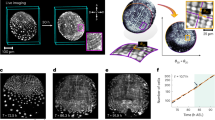Abstract.
We have investigated the mechanism of formation of the body of a typical vertebrate, the chicken. We find that the body forms initially by folding at boundaries of stiffness contrast. These boundaries are dynamic lines, separating domains of different cell sizes, that are advected in a deterministic thin-film visco-elastic flow. While initially roughly circular, the lines of elastic contrast form large “peanut” shapes evoking a slender figure-8 at the moment of formation of the animal body, due to deformation and flow in a quadrupolar stretch caused by mesoderm migration. Folding of these “peanut” or “figure-8” motives along the lines of stiffness contrast creates the global pattern of the animal, and segregates several important territories. The main result is that the pattern of cell texture in the embryo serves simultaneously two seemingly different purposes: it regionalizes territories that will differentiate to different cell types and it also locks the folds that physically segregate these territories. This explains how the different cellular types segregate in physically separated domains.
Graphical abstract

Similar content being viewed by others
References
C. Darwin, On the origin of Species by means of natural selection of the preservaton of favoured races in the struggle for life (1859)
M. Mallo, C.R. Alonso, Development 140, 3951 (2013)
L. Wolpert, Principles of Development, 3rd edition (Oxford University Press, Oxford, 2007)
J.D. Bénazet, R. Zeller, Cold Spring Harb. Perspect. Biol. 1, a001339 (2009)
G. Forgacs, R.A. Foty, Y. Shafrir, M.S. Steinberg, Biophys. J. 74, 2227 (1998)
V. Fleury, Eur. Phys. J. Appl. Phys. 45, 30101 (2009)
V. Fleury, Organogenesis 2, 1 (2005)
C. Cui, X. Yang, M. Chuai, J.A. Glazier, C.J. Weijer, Dev. Biol. 284, 37 (2005)
O.P. Boryskina, A. Al-Kilani, V. Fleury, Eur. Phys. J. AP 55, 21101 (2011)
R. Allena, D. Aubry, Comput. Methods Biomech. Biomed. Engin. 15, 445 (2012)
I. Cheddadi, P. Saramito, B. Dollet, C. Raufaste, F. Graner, Eur. Phys. J. E 34, 1 (2011)
S.A. Sandersius, C.J. Weijer, T.J. Newman, Phys. Biol. 8, 045007 (2011)
I. Bonnet, P. Marcq, F. Bosveld, L. Fetler, Y. Bellaïche, F. Graner, J. R. Soc. Interface 9, 2614 (2012)
T. Lecuit, P.F. Lenne, Nat. Rev. Mol. Cell Biol. 8, 633 (2007)
V. Conte, F. Ulrich, B. Baum, L. Muñoz, J. Veldhuis, W. Brodland, M. Miodownik, PloS One 7, e34473 (2012)
B. He, K. Doubrovinski, O. Polyakov, E. Wieschaus, Nature 508, 392 (2014)
M.A. Wyczalkowski, Z. Chen, B.A. Filas, V.D. Varner, L.A. Taber Birth Defects Res. Part C: Embryo Today: Reviews 961322012
S. Gilbert, Developmental Biology, Chapt. 13, 6th edition (Sunderland, 2000)
A. Romanoff, The Avian Embryo (The Macmillan Company, New York, 1960)
M. Callebaut, E. Van Nueten, H. Bortier, F. Harrisson, J. Morphol. 255, 315 (2003)
V. Fleury, Biosystems, Special issue “Morphogenesis” 109, 460 (2012)
C. Stern (Editor), Gastrulation, From Cell to Embryo (University College, London, 2004)
Z. Kam, J. Minden, D.A. Agard, J.W. Sedat, M. Leptin, Development 112, 365 (1991)
M. Behrndt, G. Salbreux, P. Campinho, R. Hauschild, F. Oswald, J. Roensch, S.W. Grill, C.P. Heisenberg, Science 338, 257 (2012)
C. Bertet, L. Sulak, T. Lecuit, Nature 429, 667 (2004)
A.S. Romer, R.S. Parsons, The Vertebrate Body (Saunders College Pub., Philadelphia, 1986)
V. Fleury, Eur. Phys. J. E 34, 73 (2011)
T. Moran, J. Exp. Biol. 13, 41 (1936)
D.T. New, J. Embryol. Exp. Morph. 3, 326 (1955)
D.F. Kirunda, S.R. McKee, Poult. Sci. 79, 1189 (2000)
E.N. Harvey, G. Fankhauser, J. Cell. Comp. Physiol. 3, 463 (1933)
C. Kemball, Trans. Faraday Soc. 28, 866 (1932)
V. Hamburger, H.L. Hamilton, Dev. Dyn. 195, 231 (1992)
B. Shraiman, Proc. Natl. Acad. Sci. U.S.A. 102, 3318 (2005)
GEISHA, Gallus Expression In Situ Hybridization data base, http://geisha.arizona.edu/geisha/
Author information
Authors and Affiliations
Corresponding author
Electronic supplementary material
Supplementary material
Supplementary material
Supplementary material
Supplementary material
Supplementary material
Supplementary material
Supplementary material
Supplementary material
Supplementary material
Supplementary material
Supplementary material
Supplementary material
Supplementary material
Rights and permissions
About this article
Cite this article
Fleury, V., Chevalier, N., Furfaro, F. et al. Buckling along boundaries of elastic contrast as a mechanism for early vertebrate morphogenesis. Eur. Phys. J. E 38, 6 (2015). https://doi.org/10.1140/epje/i2015-15006-7
Received:
Revised:
Accepted:
Published:
DOI: https://doi.org/10.1140/epje/i2015-15006-7




